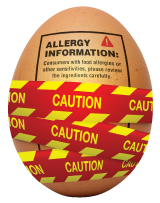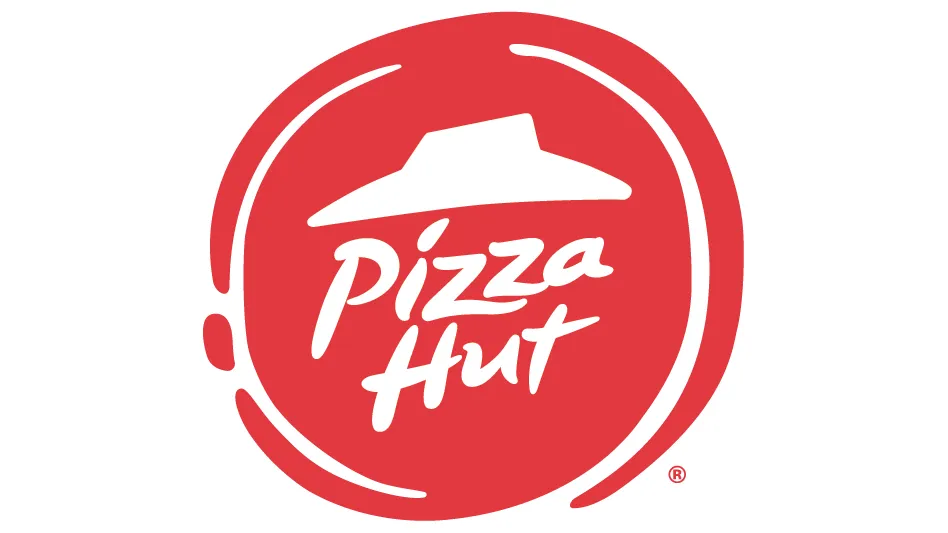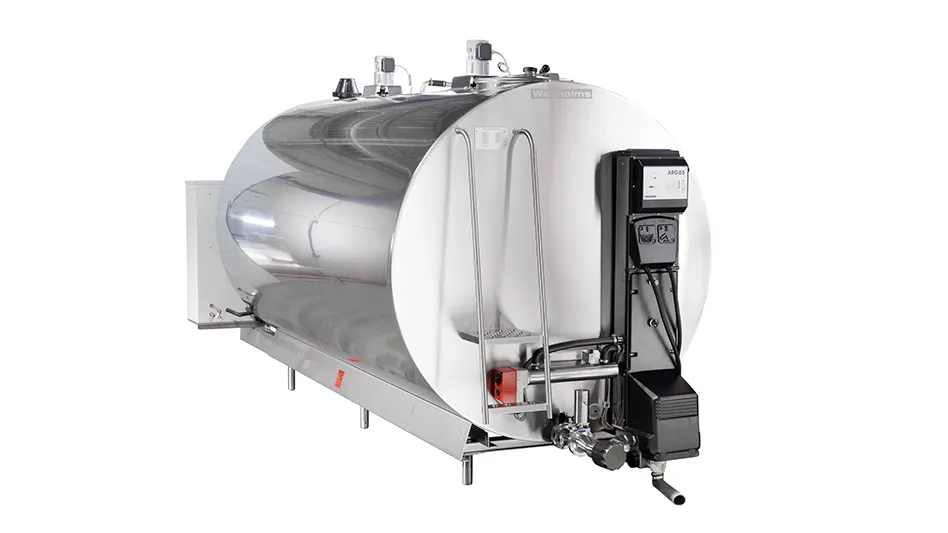 Editor’s Note: This article addresses the regulated food allergens in North America. If you distribute your product to other countries, you will need to research their respective labeling requirements.
Editor’s Note: This article addresses the regulated food allergens in North America. If you distribute your product to other countries, you will need to research their respective labeling requirements.
You just learned of yet another recall due to food allergens. After the initial sigh of relief that it isn’t your company’s or your suppliers’ product, are you wondering if the food allergens in your raw materials (ingredients, processing aids, and product contact packaging) are identified on your labels?
Regulated Food Allergens. A “regulated food allergen” is one which has been identified by a regulatory body, such as FDA, USDA, CFIA. These allergens/proteins, in any quantity, must be declared on the label. Raw agricultural commodities such as fresh fruits and vegetables in their natural state (not waxed or further processed) are exempt from these labeling requirements.
UNITED STATES
CURRENT – The food allergen labeling requirements were initiated with the Food Allergen Labeling and Consumer Protection Act of 2004 (FALCPA). This Act outlines eight major food groups esponsible for 90% of the allergenic reactions in the U.S. population.
The major food groups (in alphabetical order) are:
- Crustacean shellfish (e.g., lobster, shrimp, crayfish) – The species must be identified on the ingredient declaration.
- Eggs – Specifically chicken. But if an individual is allergic to chicken eggs, he/she has a high probability of being allergic to all bird eggs. If using eggs other than from chickens, it is recommended that the species be named, e.g., duck eggs.
- Fish (e.g., tuna, catfish, eel) – The species must be identified on the ingredient declaration.
- Milk
- Peanuts
- Soybeans – Refined, bleached, deodorized soybean oil is not a food allergen since the protein chain that causes allergic reactions is destroyed in the manufacturing process. Highly refined oils are the only FALCPA exemption from allergen declaration.
However, soy lecithin does contain some intact soy protein chains, thus, is to be treated as a regulated allergen. In addition, the source of the lecithin must be declared on the ingredient declaration, “soy lecithin.” - Tree nuts – The species must be identified on the ingredient declaration. Each tree nut is a separate allergen; e.g., a person who is allergic to walnuts may not be allergic to pine nuts. Cross contamination from one nut to a different type is just as serious as a cross between two dissimilar, regulated allergens. The FDA has provided guidance as to the nuts that are considered allergenic. This list can be found by an Internet search “FDA nut list,” or visit: http://www.fda.gov/Food/GuidanceComplianceRegulatoryInformation/GuidanceDocuments/FoodLabelingNutrition/ucm059116.htm.
- Wheat – The term “wheat” encompasses all species in the genus Triticum, including common wheat, durum, club, spelt, semolina, Einkorn, emmer, kamut, and triticale.
Upcoming Changes – There has been public interest in expanding this list to reflect the food allergens regulated in Canada; however, the FDA has not highlighted this as a current issue.
CANADA
CURRENT – The Canadian Food Inspection Agency (CFIA) has adopted and expanded on the U.S. list, including:
- The general use of the description “tree nuts” has been replaced with a list of tree nuts that must be included on the ingredient declaration. Canada’s tree nut list is different than that of the U.S., in that Canada’s encompasses only nine tree nuts while the U.S. has about 28. For example, coconut is listed in the U.S. list, but not Canada’s.
- Sulphites (U.S. spelling – sulfites) – Sulfites is a sensitivity or intolerance, not an allergy. A food sensitivity or intolerance reaction does not include the body’s release of histamines (allergic reaction); rather, a different reaction occurs. For sulfites, the results look very similar to those caused by a food allergy, including hives, breathing difficulties, drop in blood pressure, loss of consciousness, and possibly death.
- Sesame seeds
- Seafood – Canada expanded seafood to encompass not only fish and crustaceans, but also mollusks (e.g., oysters, clams).
Changes – The new Canadian food allergen labeling regulations take effect August 4, with expansion of the allergen/sensitizing/intolerance list and requirements clarified:
- Mustard seed will be added.
- Gluten will be added and the source (barley, oats, rye, triticale, wheat, or a hybridized strain of any of these cereals) must be identified.
- Wheat allergy and gluten intolerance (celiac disease) are two different reactions in the body. When someone has a wheat allergy, his/her immune system releases antihistamines. For an individual with celiac disease, the lining of the small intestine is damaged. Symptoms of gluten intolerance can include diarrhea, bloating, weight loss, and eventually malnutrition.
- The word “gluten” is not used in a “Contains” statement. Rather, the sources are to be identified by name, e.g., wheat, barley, rye, oats, triticale.
- Oats do not contain gluten; however, due to agriculture and subsequent handling practices, the presence of wheat and other gluten sources is common in oats.
- The plant source(s) for hydrolyzed protein must be declared (such as soy).
- Spelt and kamut will be classified as wheat for the “common name” declaration. This is the same as in the U.S., where all Triticum is to be identified as “wheat.” The only one that will be different is triticale which is the hybrid with rye. It is to be identified as triticale.
- Sulphites – When sulfiting agents are added directly to the food or when indirectly added as a component of an ingredient that is NOT exempted from component declaration, the sulfites have to be listed regardless of the level in the finished food.
- When the sulfiting agent is added as a component of an ingredient that is exempted from component declaration, the sulfites have to be declared when the level of sulfites in the finished food is greater than 10 ppm.
- Studies have shown that there is a “tolerance level” for sensitive individuals to small amounts of sulfites (<10 ppm). This is NOT true of allergens, where there is not an acceptable tolerance level.
- If a food allergen is present in wine and spirits from use of fining agents from eggs, fish, or milk, the allergen source must be shown on the prepackaged product label.
- The source of any allergen or gluten in the wax coating or their compounds must be shown on the label of prepackaged fruits and vegetables.
MEXICO
Mexican Official Standard (Spanish: Norma Oficial Mexicana, or NOM) NOM-051-SCFI/SSA1-2010, was effective January 1, 2011. It specifies labeling information for all food and non-alcoholic beverages traded in the country. Information on the requirements can be found at: http://www.fsis.usda.gov/regulations/Mexico_Requirements/index.asp. The Standard states:
4.2.2.2.3 All those ingredients and additives that cause hypersensitiveness, intolerance or allergy must be declared in compliance with the corresponding law ordinance.
It has been proven that the following foods and ingredients cause hypersensitiveness and must always be declared:
- Cereals containing gluten: for example wheat, rye, barley, oats, spelt, or its hybrids and derived products
- Crustacean and its products
- Egg and egg products
- Fish and fish products
- Peanuts and its products
- Soy and its products (except soybean oil)
- Milk and dairy products (lactose included)
- Tree nuts and derivatives
- Sulfite in concentrations of 10mg/kg or more.
U.S. Label Requirements. Labeling requirements are incredibly complex; thus the following pertains solely to the ingredient declaration requirements for the regulated food allergens. Allergen label regulations apply to all packages, regardless of the intended customer/consumer (retail, wholesale, and so forth).
While there are rare exceptions; FDA has made it clear that regulated allergens, of any quantity, cannot be considered as incidental. This requirement overrides all label exceptions previously provided for flavors, colors, and other “grouping” of materials.
Make certain you review all of your raw materials for potential allergen sources, including:
- Ingredients – Make certain the ingredient review encompasses all the components of the ingredient. For example, if your processing oil contains soy lecithin, the soy lecithin should be included in the ingredient list.
- Processing aids – Same as for ingredients.
- Product contact packaging and inserts – Although not clearly outlined in the Code of Federal Regulations (CFR), if the packaging material that comes into contact with the product contains an allergen (such as wheat starch-dusted films), the wheat starch should be listed in the ingredients. If using a “Contains” statement, the wheat should be listed with all the other allergens in the product.
- Rework – The rework must be clearly outlined on the product batch sheet.
- Materials that are in continuous/recycled use (e.g., enrobing chocolate, dusting flours). Acceptable methods for identifying the allergen content of a product are:
- The common name of the food source of the allergen is in the ingredient name, such as “milk.” For tree nuts and seafood, the specific type of nut or species of fish or Crustacean shellfish must be listed.
- And/or, the common identifier is listed in parenthesis directly after the ingredient: e.g., “whey (milk).” An exception is if the common name of the food source is provided elsewhere in the ingredient declaration
- And/or, a “Contains” statement is provided directly after the ingredient list. The “Contains” statement must include all of the allergens present in the productm e.g., “Contains: Milk, Soy.”
Harmonization. Some locations “harmonize” the products manufactured on one line or in the facility. That is, all the products have the same allergen content. This can significantly streamline product changeover since allergen cross contamination would be minimized. Items to consider first include:
- Potential loss of customers who are allergic to the outlined allergen or concerns with customer acceptance.
- The material, both the name and quantity, must be outlined on the formula or batch sheet. The FDA frowns on simply “tossing in” a handful of an allergen cocktail. This requirement also supports material traceability.
“Precautionary” Labeling
UNITED STATES
As stated earlier, the FDA does not object to allergen advisory statements, but has repeatedly stated that they should not substitute for Good Manufacturing Practices (GMP). In 2008, a public meeting was held to determine how manufacturers use advisory labeling for food allergens. Unfortunately, no conclusions were drawn. FDA continues to develop a long-term strategy that will help manufacturers use voluntary allergen advisory labeling that is not misleading, conveys a clear and uniform message, and adequately informs food-allergic consumers and their caregivers.
Myths
Myths about the use of precautionary statements, such as “May contain,” have spread through the industry. Some of these are:
Myth: “May contain” or similar precautionary statement is required on the label.
Fact: Historically, both the FDA and CFIA have had no objection to the voluntary use of a precautionary statement. However, this may be changing and this type of “warning statement” is not allowed in some countries.
Myth: The “May contain” can be used instead of an Allergen Management Program.
Fact: The FDA’s current stance, which will be expanded with the Food Safety Modernization Act, is that a robust Allergen Management Program must be implemented and validated as effective.
Myth: There is no legal liability for an allergic reaction if there is a precautionary statement.
Fact: While a precautionary statement provides a “warning” to the customer, it does not absolve the company.
Myth: The precautionary statement would prevent a recall for an allergen that is present and not on the ingredient declaration.
Fact: Recalls have and will continue to occur, if the allergen is present and not listed on the ingredient declaration or “Contains” statement. A “May contain” statement will not prevent a recall for undeclared allergens.
Myth: Adding all allergens in a “Contains” statements replaces the need for an Allergen Management Program.
Fact: Only the allergens listed in your formula/batch sheets (ingredients) and in other raw materials (processing aids and product contact packaging material) may be listed in the ingredient declaration.
Myth: Products sold wholesale do not need an ingredient declaration.
Fact: With rare exceptions, the following label components are required for wholesale, retail, and foodservice items. These include:
- Product identity.
- Net contents statement.
- Ingredient/allergen declaration.
- Manufacturer or distributor name/address.
- Traceability information/lot number (required under the Bioterrorism Act).
CANADA
Health Canada’s current policy on food allergen precautionary statements is similar to FDA’s, requiring only that such statements be truthful, clear, and non-ambiguous; and that they not be a substitute for GMPs. Health Canada and CFIA are reviewing the current policy and moving toward a more prescriptive approach. They are recommending that food manufacturers and importers begin to use only “May contain [X]” or “Not suitable for consumption by persons with an allergy to [X]” on food labels.
In May 2011, Health Canada issued an information update cautioning consumers with wheat allergies that other cereal grains may contain low levels of wheat because of the way these grains are grown and harvested. Thus, Health Canada and CFIA have advised food manufacturers to use a “may contain wheat” statement when using grain products that may contain low levels of wheat.
MEXICO
No formal policy has been issued by Mexico on precautionary statements.
For more information on any of these topics, we recommend an Internet search on “Food Allergen Labeling” and the name of the country of interest. Questions can also be sent to AIB International:
- Labeling – Labelorder@aibonline.org
- Allergen Management Program – FoodSafetyEducation@aibonline.org.
The authors are HACCP Coordinator; Director, Food Safety Education; and Director, Food Labeling, respectively, for AIB International.
Latest from Quality Assurance & Food Safety
- Food Safety Summit Keynote Focuses on Food Safety Leadership
- FDA Publishes Landmark Final Rule to Enhance the Safety of Agricultural Water
- The Wendy's Company Reports 2023 Corporate Responsibility Progress
- Local Bounti Opens New Controlled Environment Agriculture Facility
- Tröegs Partners with Patagonia Provisions to Introduce Kernza Lager
- Neogen Launches New Molecular Method for Detection of Two Salmonella Serotypes
- Standard Meat Company Appoints Keith Blanks as Chief Commercial Officer
- USDA Finalizes Policy to Protect Consumers from Salmonella in Raw Breaded Stuffed Chicken Products




